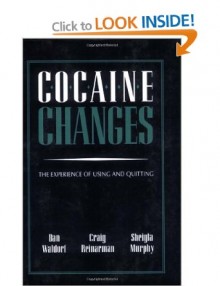A large-scale research project involving current and former heavy users of cocaine, conducted by by Dan Waldorf and colleagues, reveals important insights into how people use cocaine and how they stop using the drug. (3,706 words)
The Drug Experience: Cocaine, Part 1
Exploring the dynamic world of heavy cocaine use as revealed in a provocative, high-quality study by Dan Waldorf and colleagues. This research, conducted in the US in the 1980s, challenged many of the prevailing myths about cocaine. (875 words)
There is a good deal of misinformation about cocaine, which does little to help society tackle the problems that excess use of this drug can produce.
In their book Cocaine Changes: The Experience of Using and Quitting, Dan Waldorf and his colleagues state that they set out to study cocaine users and present their world as they see it, without making moral judgements about the drug-using behaviours.
The research involved interviewing 267 current and former heavy users of cocaine from Northern California. The sample did not include people in treatment programmes or in prison, as is common in other research. Most of the respondents were ‘solidly working- or middle-class, fairly well-educated, and steadily employed.’
Nearly all the respondents first tried cocaine when it was offered by a trusted friend. Many of the sample reported that they did not get high the first time they snorted cocaine. They had to learn both to experience and then to appreciate the subtle euphoric effects of the drug.
The majority of respondents increased their use gradually—there was no uniform progression or pattern. The slow escalation was likely due in part to the general greater availability of the drug. Two other factors were often cited as contributing to escalating use: a slow increase in tolerance for the drug, and the seductive and insidious nature of the drug itself.
The tolerance reported with cocaine appeared to be somewhat different to that observed with opiates. Whilst some users reported increasing their doses of drug, they did not generally report decreased effects of the same dose. Rather than needing more of the drug to get the same effect, they reported wanting the same effect again and again.
Many participants ‘… agreed that cocaine’s euphoric effects offered not only a sense of well-being, but a feeling of mastery or power that was so reinforcing it often led them to use more frequently than they planned or expected.’
The researchers described four relatively discrete patterns of use. Hogs showed a consistent, very heavy daily use. This pattern of use caused more dramatic effects, greater compulsion, as well as marked painful ‘comedowns’ and depression.
Nippers used regularly, often every day, but only in relatively small amounts. These users kept their drug use subordinated to work and family responsibilities, and often avoided the negative effects associated with heavy use.
Bingers used cocaine heavily and then lay off the drug for days or weeks. Use was often constrained by personal finances or by prolonged negative effects. Some bingers found their binges getting longer and longer. Ceremonial or occasional users used the drug on special social occasions.
The researchers reported a considerable movement by individuals from one form of use to another. Although some users followed a downward spiral from experimental use to addiction, as many others nipped and then binged and then nipped again. Others moved from heavy binge use or sustained abuse to ceremonial use.
One striking aspect of the study was the proportion of people who used the drug on a controlled basis—approximately 50%.
Long-term daily use of cocaine or regular heavy binges often led to problems. The most frequently mentioned were nasal irritations, insomnia, paranoia, strained relationships with wife or husband, depleted savings, hangover days at work, and periodic sexual difficulties. The most frequent and severe problems were reported by the heaviest users.
Some of these problems were reported as serious, but many were not. Most of the respondents appeared to find most of the problems manageable most of the time. They seemed to get pleasure from cocaine, and accepted the problems as part of the territory.
Most of the sample agreed that moderate use of cocaine can be an exceedingly enjoyable experience —it produced euphoria, more energy, a certain intellectual focus, enhanced sensations, an increased sociability and social intimacy.
However, daily use or regular binges transformed the experience of the cocaine high. The initial euphoria slowly and subtly became dysphoria, feelings of well-being turned into feelings of being unwell and unhappy. Feeling energetic was replaced with feeling apathetic.
These changes in physical feelings were accompanied by transformations in social experience. The person used the drug in isolation, rather than in social groups as was done initially.
Some heavy users noted psychological transformations. The world that had once been good to live in became a place that was far less hospitable—paranoia increased and depression sometimes developed.
A shift in the balance between positive and negative effects of cocaine occurred. The shift to the negative often resulted in considerable psychological pain, and a questioning of the rationality and desirability of continuing to use the drug.
At this time, those people with conventional stakes in families, homes, jobs, communities and identities tended to find the resources and resolve to abstain or reduce their drug use.
Those with fewer such stakes and social supports were more likely to feel indecisive and helpless to overcome their cocaine use problem.
Recommended reading:
Cocaine Changes: The Experience of Using and Quitting by Dan Waldorf, Craig Reinarman and Sheigla Murphy. Temple University Press, USA.
> Part 2
Factors Facilitating Recovery: Overcoming Withdrawal Symptoms
 People who decide to stop taking drugs or drinking alcohol after using or drinking for long periods of time, need to be aware that they might experience withdrawal effects which can be irritating, debilitating and even life-threatening.
People who decide to stop taking drugs or drinking alcohol after using or drinking for long periods of time, need to be aware that they might experience withdrawal effects which can be irritating, debilitating and even life-threatening.
Many of these withdrawal signs, which can be psychological and physical in nature, are generally opposite to the effects the person experienced when the drug was being taken. For example, abrupt withdrawal from long-term use of Valium (diazepam) and other benzodiazepines, drugs which are prescribed to alleviate anxiety and insomnia, can lead to pronounced anxiety, insomnia, agitation, intrusive thoughts and panic attacks.
In addition, people withdrawing from benzodiazepines can experience physical withdrawal signs, such as burning sensations, feeling of electric shocks, and full-blown seizures. The duration and strength of these withdrawal signs is in part dependent on the amounts of drug having been used and the duration of time the person has been using the drug.
Historical Perspectives: Cocaine
Traces the history of cocaine, linking the Incas, Freud, Thomas Edison, Sherlock Holmes and Coca Cola. (880 words)
Crack in America
 Yesterday, I ran a blog written by Bill White showing the questionable ‘science’ that surrounded the so-called issue of crack babies. There was tremendous media hype about crack and crack babies at the time. Why?
Yesterday, I ran a blog written by Bill White showing the questionable ‘science’ that surrounded the so-called issue of crack babies. There was tremendous media hype about crack and crack babies at the time. Why?
I wrote on this issue in the educational series I wrote for Drink and Drugs News nearly a decade ago. Here’s what I wrote in a longer article entitled ‘Regulation and control of drugs: Part 2’.
‘In their book Crack in America, Craig Reinarman and Harry Levine point out the politics that surrounded crack in the US during the 1980s and 90s. Crack first appeared in late 1984 and 1985, primarily in impoverished African-American and Latino inner city neighbourhoods in New York, Los Angeles and Miami.
‘Moral panics, the limits of science & personal responsibility’ by Bill White
 Another classic from Bill White, illustrating how junk science can dominate the sensationalist media and create moral panic, which of course can be used for political gain.
Another classic from Bill White, illustrating how junk science can dominate the sensationalist media and create moral panic, which of course can be used for political gain.
‘From the mid-1980s to the mid-1990s, new patterns of crack cocaine use dominated cultural headlines in sensationalized media frenzies that sociologists refer to as moral panics. Other than cocaine-related violence, no aspect of this alarm garnered greater attention than the images of premature, cocaine-exposed infants trembling within incubators of neonatal intensive care units. Those infants and children became widely caricatured as “crack babies” and “crack kids” and their images were exploited to forge new laws and policies that in turn fueled dramatic expansions of the U.S. criminal justice and child welfare systems.
Those most dramatically affected by the expansions were poor communities of color who witnessed unprecedented numbers of their young men imprisoned and their young women and children placed under the control of state child protection authorities.

 For a period of four years from 15th November 2004, I wrote a series of Background Briefings for
For a period of four years from 15th November 2004, I wrote a series of Background Briefings for 

